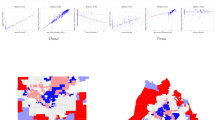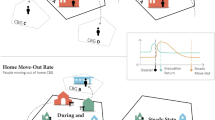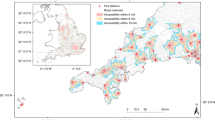Abstract
Emergency responders in coastal cities are anticipated to provide effective evacuation of at-risk populations during the preparedness and response phases of coastal floods due to land-falling storms or cyclones. However, existing contingency plans primarily focus on the evacuation of the general public rather than special arrangement for elderly populations who constitute a large proportion of flood fatalities. Here we present a system-level methodology to elaborate citywide coastal flood evacuation plans for optimal deployment of shelters and effective transfer of elderly people with special needs. We conduct a comparative analysis between Shanghai and New York City, which are both among the most exposed coastal cities to storm-induced flooding but represent two distinct institutional systems of emergency operation. The results show marked disparities in evacuation patterns for elderly residents in the two cities. Storm flood evacuation is more challenging in Shanghai due to insufficient provision of shelter capacity (~230,000). Implementing risk-informed and strategic planning could not only meet the potentially huge demand of vulnerable elderly (~520,000) but also improve the overall efficiency of evacuee transfer by a factor of 3. Our work provides new insights into operational emergency evacuation decisions and informs flood management policy development for major coastal cities globally.
This is a preview of subscription content, access via your institution
Access options
Subscribe to this journal
Receive 12 digital issues and online access to articles
$99.00 per year
only $8.25 per issue
Buy this article
- Purchase on Springer Link
- Instant access to full article PDF
Prices may be subject to local taxes which are calculated during checkout






Similar content being viewed by others
Data availability
The traffic network data, demographic data, evacuation centre data and evacuation zone map for NYC are freely available from the United States Census Bureau (https://www.census.gov/) and the NYC Open Data Portal (https://opendata.cityofnewyork.us/). The transport network and POI data in Shanghai are obtained from the AMAP Data Portal under licence. Shelter data in Shanghai are derived from the Shanghai municipal civil defence office (https://mfbwz.mfb.sh.gov.cn/mfbwz/mfb/yjbncs/map.html#). The population census data are provided by the Shanghai Statistics Bureau. The topographic data and seawall/floodwall data are collated from Shanghai Municipal Institute of Surveying and Mapping and Shanghai Water Authority, respectively. Certain datasets of Shanghai are available from the authors upon reasonable request and with permission of the parties that provided the data.
Code availability
Data analysis and results representation were produced by using Origin software (https://www.originlab.com) and ESRI ArcGIS (https://www.esri.com). FloodMap modelling software was used with permission from co-author D.Y.
References
Kates, R. W., Colten, C. E., Laska, S. & Leatherman, S. P. Reconstruction of New Orleans after Hurricane Katrina: a research perspective. Proc. Natl Acad. Sci. USA 103, 14653–14660 (2006).
Lin, N., Emanuel, K., Oppenheimer, M. & Vanmarcke, E. Physically based assessment of hurricane surge threat under climate change. Nat. Clim. Chang. 2, 462–467 (2012).
Nicholls, R. J. et al. A global analysis of subsidence, relative sea-level change and coastal flood exposure. Nat. Clim. Chang. 11, 338–342 (2021).
Jongman, B., Ward, P. J. & Aerts, J. C. Global exposure to river and coastal flooding: long term trends and changes. Global Environ. Chang. 22, 823–835 (2012).
Aerts, J. C. et al. Evaluating flood resilience strategies for coastal mega-cities. Science 344, 473–475 (2014).
Yin, J., Yu, D., Yin, Z., Wang, J. & Xu, S. Modelling the anthropogenic impacts on fluvial flood risks in a coastal mega-city: a scenario-based case study in Shanghai, China. Landsc. Urban Plan. 136, 144–155 (2015).
Kreibich, H. et al. The challenge of unprecedented floods and droughts in risk management. Nature 608, 80–86 (2022).
IPCC. Climate Change 2021: The Physical Science Basis (Cambridge Univ. Press, 2021).
IPCC. Climate Change 2022: Impacts, Adaptation and Vulnerability (Cambridge Univ. Press, 2022).
Hanson, S. et al. A global ranking of port cities with high exposure to climate extremes. Clim. Change 104, 89–111 (2011).
Hallegatte, S., Green, C., Nicholls, R. J. & Corfee-Morlot, J. Future flood losses in major coastal cities. Nat. Clim. Chang. 3, 802–806 (2013).
White, G. F. Human Adjustment to Floods: Department of Geography Research Paper No. 29 (Univ. Chicago, 1945).
Hall, J. W. et al. A methodology for national-scale flood risk assessment. J. Water Maritime Eng. 156, 235–247 (2003).
Rosenzweig, C. & Solecki, W. Hurricane Sandy and adaptation pathways in New York: lessons from a first-responder city. Global Environ. Chang. 28, 395–408 (2014).
Tullos, D. How to achieve better flood-risk governance in the United States. Proc. Natl Acad. Sci. USA 115, 3731–3734 (2018).
Logan, T. M., Guikema, S. D. & Bricker, J. D. Hard-adaptive measures can increase vulnerability to storm surge and tsunami hazards over time. Nat. Sustain. 1, 526–530 (2018).
Larson, L. & Plasencia, D. No adverse impact: new direction in floodplain management policy. Nat. Hazards Rev. 2, 157–181 (2001).
Yin, J., Yu, D., Lin, N. & Wilby, R. Evaluating the cascading impacts of sea level rise and coastal flooding on emergency response spatial accessibility in Lower Manhattan, New York City. J. Hydrol. 52, 648–658 (2017).
Urbina, E. & Wolshon, B. National review of hurricane evacuation plans and policies: a comparison and contrast of state practices. Transport. Res. A 37, 257–275 (2003).
Kim, J. & Oh, S. S. Confidence, knowledge, and compliance with emergency evacuation. J. Risk Res. 18, 111–126 (2015).
Feng, K. & Lin, N. Reconstructing and analyzing the traffic flow during evacuation in Hurricane Irma (2017). Transport. Res. D 94, 102788 (2021).
Southworth, F. Regional Evacuation Modeling: A State-of-the-Art Review (Oak Ridge National Laboratory, 1991).
Bayram, V. Optimization models for large scale network evacuation planning and management: a literature review. Surv. Oper. Res. Manag. Sci. 21, 63–84 (2016).
FEMA. Guide for All-Hazard Emergency Operations Planning (Federal Emergency Management Agency, 1996).
FEMA. Design and Construction Guidance for Community Safe Rooms (Federal Emergency Management Agency, 2008).
Sherali, H. D., Carter, T. B. & Hobeika, A. G. A location–allocation model and algorithm for evacuation planning under hurricane/flood conditions. Transport. Res. B 25, 439–452 (1991).
Kalafatas, G. & Peeta, S. Planning for evacuation: insights from an efficient network design model. J. Infrastruct. Syst. 15, 21–30 (2009).
Ng, M. & Lin, D. Y. Sharp probability inequalities for reliable evacuation planning. Transport. Res. C 60, 161–168 (2015).
Lindell, M. K. & Perry, R. W. The protective action decision model: theoretical modifications and additional evidence. Risk Anal. 32, 616–632 (2012).
NYC Hurricane Sandy After Action: Report and Recommendations to Mayor Michael R. Bloomberg (NYC Mayor’s Office, 2012).
Coates, L. Flood fatalities in Australia, 1788–1996. Aust. Geogr. 30, 391–408 (1999).
Rappaport, E. N. Loss of life in the United States associated with recent Atlantic tropical cyclones. Bull. Am. Meteorol. Soc. 81, 2065–2073 (2000).
Diakakis, M. & Deligiannakis, G. Flood fatalities in Greece, 1970–2010. J. Flood Risk Manag. 10, 115–123 (2017).
Jonkman, S. N., Maaskant, B., Boyd, E. & Levitan, M. L. Loss of life caused by the flooding of New Orleans after Hurricane Katrina: analysis of the relationship between flood characteristics and mortality. Risk Anal. 29, 676–698 (2009).
Yu, D. et al. Disruption of emergency response to vulnerable populations during floods. Nat. Sustain. 3, 728–736 (2020).
Wolshon, B., Urbina, E., Levitan, M. & Wilmot, C. Review of policies and practices for hurricane evacuation. ii: traffic operations, management, and control. Nat. Hazards Rev. 6, 143–161 (2005).
Gori, A., Lin, N., Xi, D. & Emanuel, K. Tropical cyclone climatology change greatly exacerbates US extreme rainfall-surge hazard. Nat. Clim. Chang. 12, 171–178 (2022).
Vousdoukas, M. I. et al. Climatic and socioeconomic controls of future coastal flood risk in Europe. Nat. Clim. Chang. 8, 776–780 (2018).
Becker, M., Karpytchev, M. & Hu, A. Increased exposure of coastal cities to sea-level rise due to internal climate variability. Nat. Clim. Chang. 13, 367–374 (2023).
Rentschler, J., Salhab, M. & Jafino, B. A. Flood exposure and poverty in 188 countries. Nat. Commun. 13, 3527 (2022).
Zachry, B. C., Booth, W. J., Rhome, J. R. & Sharon, T. M. A national view of storm surge risk and inundation. Weather Clim. Soc. 7, 109–117 (2015).
Yu, D. & Lane, S. N. Interaction between subgrid-scale resolution, feature representation and grid-scale resolution in flood inundation modelling. Hydrol. Process. 25, 36–53 (2011).
Bates, P. D., Horritt, M. & Fewtrell, T. A simple inertial formulation of the shallow water equations for efficient two-dimensional flood inundation modelling. J. Hydrol. 387, 33–45 (2010).
Yin, J., Yu, D., Yin, Z., Wang, J. & Xu, S. Modelling the combined impacts of sea-level rise and land subsidence on storm tides induced flooding of the Huangpu River in Shanghai, China. Clim. Change 119, 919–932 (2013).
Yin, J., Lin, N. & Yu, D. Coupled modeling of storm surge and coastal inundation: a case study in New York City during Hurricane Sandy. Water Resour. Res. 52, 8685–8699 (2016).
Yin, J. et al. Flood risks in sinking delta cities: time for a reevaluation? Earth’s Future 8, e2020EF001614 (2020).
Brussee, A. R. et al. Impact of hydraulic model resolution and loss of life model modification on flood fatality risk estimation: case study of the Bommelerwaard, the Netherlands. J. Flood Risk Manag. 14, e12713 (2021).
Acknowledgements
This work was supported by the National Natural Science Foundation of China (grant no. 42371076), Science and Technology Commission of Shanghai Municipality (grant no. 21230750600), the Engineering and Physical Sciences Research Council of UK (grant no. R034214/1) and Hong Kong Research Grants Council-Early Career Scheme (grant no. 27202419). N.L. has received funding from the National Science Foundation of the United States (grant no. 1652448). D.Y. and R.W. were funded by the UK Natural Environment Research Council (grant no. NE/R009600/1 and NE/S017186/1). J.B. acknowledged financial support from the Netherlands Organization for Scientific Research (NWO) (grant no. ALWSD.2016.007).
Author information
Authors and Affiliations
Contributions
J.Y. conceived the study, prepared the dataset, interpreted the result and drafted the manuscript. J.Y. and D.Y. designed the initial emergency evacuation model. R.W., N.L., N.W., S.L., J.B. and M.G. contributed to the further development of the methods and provided guidance on the optimization of shelter deployment. J.Y. and Y.Y. performed flood inundation modelling and network-based geospatial analysis. B.S. and L.Y. assisted in the questionnaire survey. All authors commented on the manuscript and gave final approval for publication.
Corresponding authors
Ethics declarations
Competing interests
The authors declare no competing interests.
Peer review
Peer review information
Nature Water thanks Robert Nicholls and the other, anonymous, reviewer for their contribution to the peer review of this work.
Additional information
Publisher’s note Springer Nature remains neutral with regard to jurisdictional claims in published maps and institutional affiliations.
Supplementary information
Supplementary Information
Supplementary Figs. 1–5, Table 1, methods, references and appendix.
Rights and permissions
Springer Nature or its licensor (e.g. a society or other partner) holds exclusive rights to this article under a publishing agreement with the author(s) or other rightsholder(s); author self-archiving of the accepted manuscript version of this article is solely governed by the terms of such publishing agreement and applicable law.
About this article
Cite this article
Yin, J., Yang, Y., Yu, D. et al. Strategic storm flood evacuation planning for large coastal cities enables more effective transfer of elderly populations. Nat Water 2, 274–284 (2024). https://doi.org/10.1038/s44221-024-00210-z
Received:
Accepted:
Published:
Issue Date:
DOI: https://doi.org/10.1038/s44221-024-00210-z



